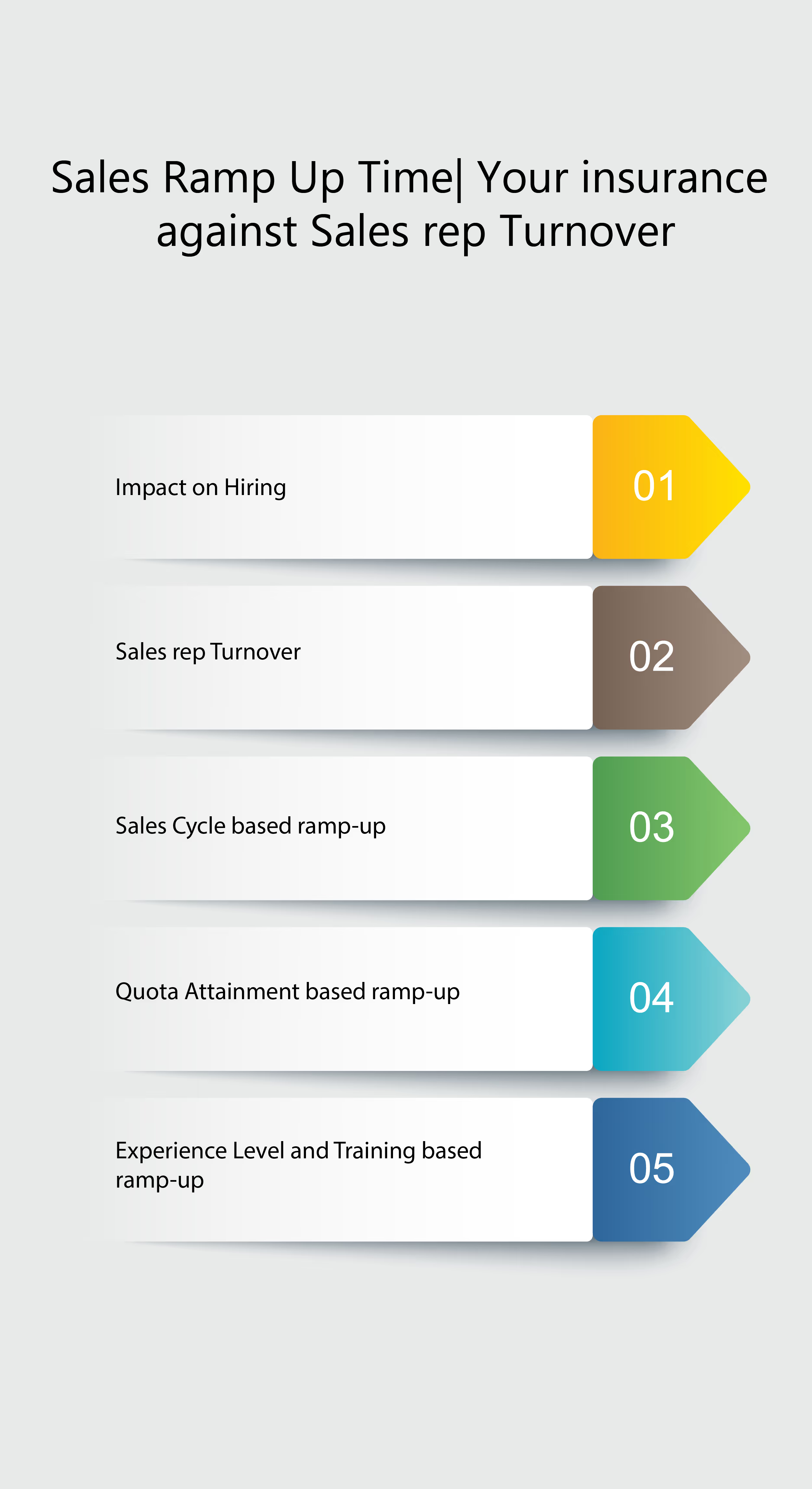
Blog
Sales Ramp Up Time| Your insurance against Sales rep Turnover
May 30, 2022


Key Insights
While we start on this blog a great quote from Mark Twain comes to mind- “The secret of getting ahead is getting started”. If you are here to know more about sales ramp-up times and curious to find out ways to improve them, you are on your way to getting ahead of the competition. Read on!
Sales teams are always under pressure to perform no matter what the sales ecosystem is like. If your sales team cannot maintain enough cash flow, you are faced with the prospect of running out of business. Salespeople turnover is another factor you have to consider as a business leader. You have to hire capable talent and bring them up to speed as quickly as possible so they can start contributing to sales and fill in the gaps brought on by turnover. That is when you realize how important it is to calibrate your sales ramp-up time to optimum levels. A Bridge Group study in 2017 found out that 41% of businesses average around 5 months on sales ramp up time. It does not have to be the number you go by. You can figure out your own sales ramp-up time that is appropriate for your business ecosystem. Once you figure out what your ideal sales ramp-up time is, you need to make consistent efforts to ensure the balance between hiring, sales ramp up and salesperson turnover is maintained through sales cycles.
In the sections that follow let’s take a look at how critical is sales ramp-up time and what are the various ways to optimally calculate sales ramp-up time specific to your business.
We first take a look at how sales ramp uptime is critical to your sales cycle and its impact on business.

Impact of Sales Ramp Up Time on Business
For starters let's quickly define what Sales ramp up time. It is a straightforward concept, and pretty obvious from the name. Sales ramp uptime is the total time required for new sales hires from the time they join till the time they can carry the responsibility of hitting full quota much like an experienced sales rep in your team. The time they take to stand on their own taking full responsibility for their own On Target Earnings.
Now, every business leader understands the importance of running new sales hires through onboarding and training to get them to be productive. Many business leaders take it a bit too far and rush through them through both onboarding and training into the sales cycle, more often than not, resulting in mediocre performances. It is important for a business leader to clearly understand how sales ramp-up time impacts business and how to arrive at an optimum and calibrated ramp up time.
Impact on Hiring
A sales leadership team that is fully aware of its sales ramp-up time, including the sales onboarding process, will be able to hire better to keep the right balance of talent and experience in the team, helping sales teams stay highly productive throughout.
Sales rep Turnover
Too short or too long sales ramp-ups can add to your average sales rep turnover in the longer run. Short sales ramp-ups can potentially burn out new hires. Too long sales ramp-ups can demotivate some and push them to look for greener pastures.
Know your own Sales Ramp-Up Time

There are many variables to determining the right sales ramp up time. It depends primarily on the industry your business is into, the market growth it offers, your market share and the kind of support infrastructure you provide your sales staff. Of course, training and onboarding are integral parts of the sales ramp up. You might want to refer to your industry benchmarks to figure out the ramp-up time that best suits you. There is no one magic formula to arrive at an appropriate ramp up time. Because of the many variables involved in the calculation, there are generally three well-known methods to calculate sales ramp-up times.
Sales Cycle based ramp-up
The Sales Cycle is dependent primarily on the kind of industry you do business in. Every industry has an average sales cycle. If you are calculating sales ramp-up time for fresh talent, you might want to bake in the onboarding and training period into the ramp up time. A good general practice is to allow new sales reps a buffer of 90 days or 3 months over and above your average sales cycle time.
Sales Ramp Up Time by Sales Cycle = Average Length of Sales Cycle + 90 Days buffer
Quota Attainment based ramp-up
The workplace culture has a huge impact on quota attainment. The average time taken to meet 100% of quota can be a good benchmark to start with especially in businesses where the average sales cycle time is not clear or is vague. One important component required here is a robust sales performance management system that records every sales activity and allows performance review in real-time. With an efficient sales performance management system, you will have all the data you need to calculate the average time taken to achieve 100% of quota, ensuring sales accountability, irrespective of accounts and territories assigned.

Sales Ramp Up Time by Quota Attainment = Average Length of Time to Meet 100% Quota
Experience Level and Training based ramp-up
This method of calculating sales ramp-up time takes into account the sales experience your new hires carry along with the sales cycle time.
Sales Ramp Up Time by Experience and Training = Training Period + Average Sales Cycle Time + Time assumed against experience.
The time assumed against experience can be just a time period assigned in an ad hoc fashion based on how fresh or experienced the candidate is. For example, you could assign a time period of 2 weeks for an experienced hand, while allowing 2 months of the time period for a fresher with no experience. The more the experience the lesser time considered against experience.
Conclusion
In many cases, it is a process of discovery for sales leaders as they progress. The above methods are only guidelines for sales leaders to benchmark their sales ramp up time. As they say, there is always room for improvement, Sales leaders should always look for bettering their sales ramp up time.
One way to have a tight leash on sales ramp-up times is to have a nimble, real-time and robust sales performance management system. Sales Performance Management (SPM) from Kennect offers you exactly this and more. SPM allows you to keep a track of performances and draw intelligent inferences from the past.
Along with Incentive Compensation Management (ICM), another lightweight solution from Kennect, you can enable your sales teams to discover innovative ways of reducing the sales ramp-up time to the optimum best.
As the great Stephen Covey puts it-” I am not a product of my circumstances, I am a product of my decisions”. Make that important decision to improve your sales ramp-up time, Ask for a quick demo today.
ReKennect : Stay ahead of the curve!
Subscribe to our bi-weekly newsletter packed with latest trends and insights on incentives.
Thank you! Your submission has been received!
Oops! Something went wrong while submitting the form.
Your data is in safe hands. Check out our Privacy policy for more info





%20(1).avif)










